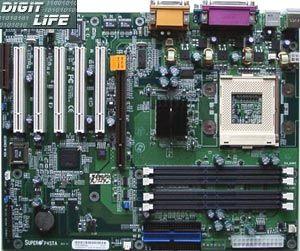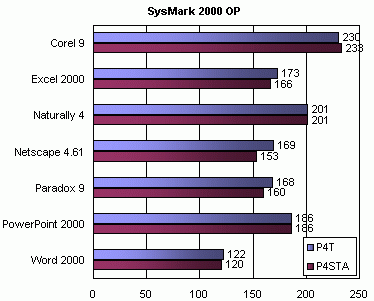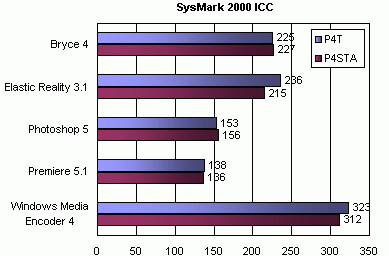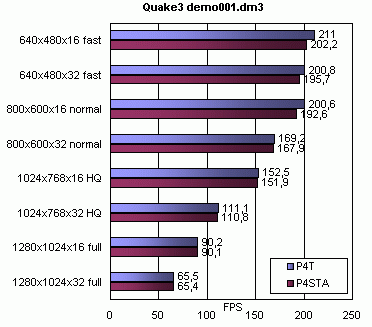 |
||
|
||
| ||
Right after release of the Intel Pentium 4 and the i850 chipset no every famous mobo manufacturer announced their series of boards on this chipset at once. Misfortune with the previous platforms for RDRAM and high cost of the board itself undoubtedly restrain spreading of the new technology. Especially considering that an increased complexity of the chipset and high frequencies of the system operation make difficulties for production and independent development of motherboards. But since we understand now that the latest processor from Intel (or rather the well balanced chipset) is quite successful, the i850 can be found in the road maps of many motherboard manufacturers. We have already considered ASUS and GigaByte products and they have made rather good impression on us. We will hardly see some unusual solutions on the i850. Today their features are rather decent - there are only 5 PCI slots, no IDE RAID and other peculiar features of the modern boards on the i815 and the Apollo Pro 133A. Right after the ASUS P4T and GigaByte 8TX we have tested the Intel i850 based card for the CPU Intel Pentium 4 from SuperMicro - the P4STA. Specification
Installation and testingThe standard (for SuperMicro) big blue box contains: the SuperMicro P4STA motherboard, a set for installation of the CPU's heatsink, one UltraATA100 cable, one FDD cable, two modules - brackets for RIMM slots, the description, a CD with drivers and a cable for one additional USB port. Since the board is of a usual ATX format, its installation didn't cause much trouble. The Socket-423 is very similar to a usual FCPGA differing only in a larger number of pins. There is a small difference in installation of the CPU's heatsink - it's mounted not on the socket but near it.  Unlike ASUS, SuperMicro didn't provide the board with a special device for installation in a usual ATX case. The set includes heatsink's mounts only on the motherboard or on the ATX 2.03 case. That's why with the ATX case of old specification you can use the board but you should transport it only in horizontal position. Otherwise, you can severely damage the board. Jumpers are only for RDRAM frequency to choose (auto, 300 MHz, 400 MHz) and disabling of the integrated sound. Besides, I should notice a large heatsink on the chipset, a possibility of installation of full sized boards in all expansion slots. The IDE/FDD and power supply connectors are located competently (except an additional 4-pin one - it's located on the edge of the board near the keyboard connector), their cables do not hamper an access to the processor and memory. In this case a good layout of the board is a sequent of original Intel's design. The AGP Pro slot allows using all variants of AGP video adapters (except very old AGP x1/x2 ones intended for the 3.3V bus). Integrated AC'97 sound and CNR connector do not perfectly suit an image of the high efficient PC, but the manufacturer seems to use all possibilities of the chipset, especially considering that it's not very expensive. Though I think that it would be more interesting to realize the network/HomePNA controller in the 82801BA (ICH2) chip. It's possible to control CPU and motherboard temperatures. The Winbond W83627HF-AW chip accounts for it. Besides, they provide control for three fans' rotation speeds, as well as enabling of a special overheat fan that comes into work with the temp increase. The soft support of the latter possibility is, unfortunately, absent.  The board is supplied with a new SSI 24-pin power supply connector. But it's back compatible with a usual ATX, that's why there mustn't be any difficulties. The additional cables are of the same 3.3, 5 and 12 V. The systems with the Pentium 4 require powerful and high quality power supply units. The SSI connector allows using either a new unit with a such connector or a usual ATX one with an additional 4-pin cable. SuperMicro uses the Ami BIOS in the majority of their boards, but in this case they chose the AWARD, despite the fact that Ami has a version for the Intel Pentium 4 as well. The overclocking possibilities are absent except for changing of a CPU multiplier (which is usually locked). Another interesting feature is that the BIOS has the AWDFLASH utility. Since a PC has to loaded in DOS mode for this utility to enable and there are not many such PCs left, the utility was installed right in the BIOS. When pressing a combination of keys while the PC is loading the utility gets unpacked and starts. All you need is to put a diskette with the new BIOS in the FDD. The SuperMicro products were always reliable and high quality. The P4STA board isn't an exception and performed very well in the tests. PerformanceYou will hardly find a great variety of the i850 based boards that's why the P4STA performance was compared only with the ASUS P4T board. Test system:
Software:
   As you can see, the boards' speeds are very similar. It was expected due to equal chipsets and the BIOS from the same manufacturer. The both top manufacturers used all possibilities of the i850 chipset. A choice among them will be base on personal preference, an appearance and configuration. ConclusionOn the one hand, the SuperMicro P4STA board is
a usual board for the CPU Intel Pentium 4, and on the other hand
high performance due to the i850 and high reliability provided by
SuperMicro can be attractive in case the most modern solutions are
required. That's why it has a chance to take the appropriate place
in the not very rich market of the i850 based boards. I can hardly
mark out some definite advantages and downsides (except the price
of course) - an ordinary card (for the fastest CPU Intel, though)
which is still capable of fighting against the ASUS as equals.
Write a comment below. No registration needed!
|
Platform · Video · Multimedia · Mobile · Other || About us & Privacy policy · Twitter · Facebook Copyright © Byrds Research & Publishing, Ltd., 1997–2011. All rights reserved. |